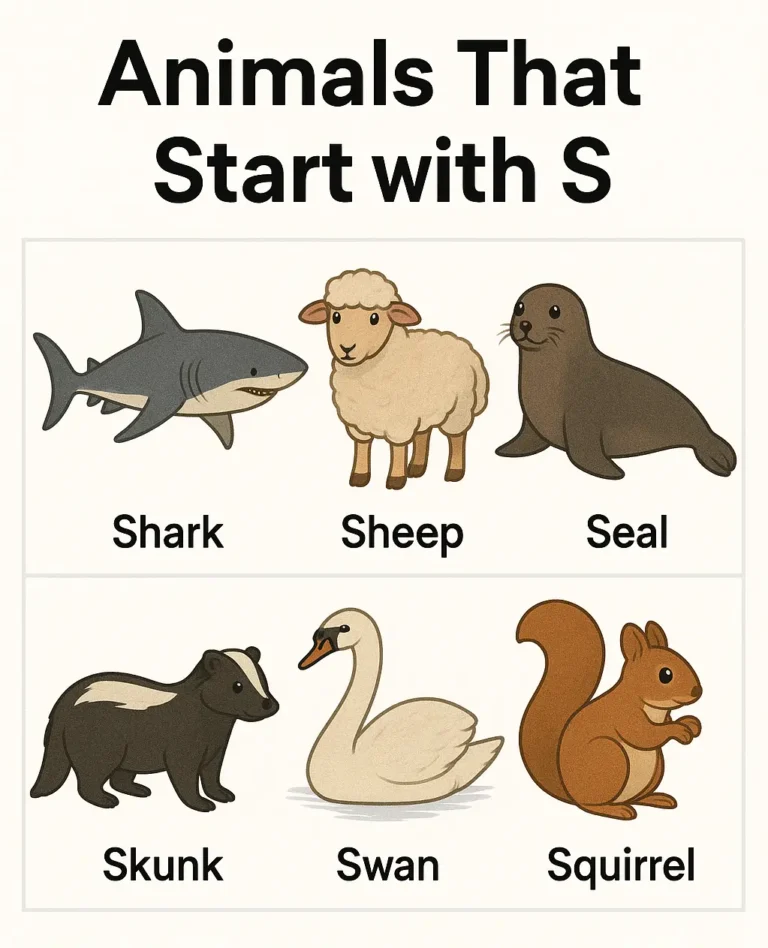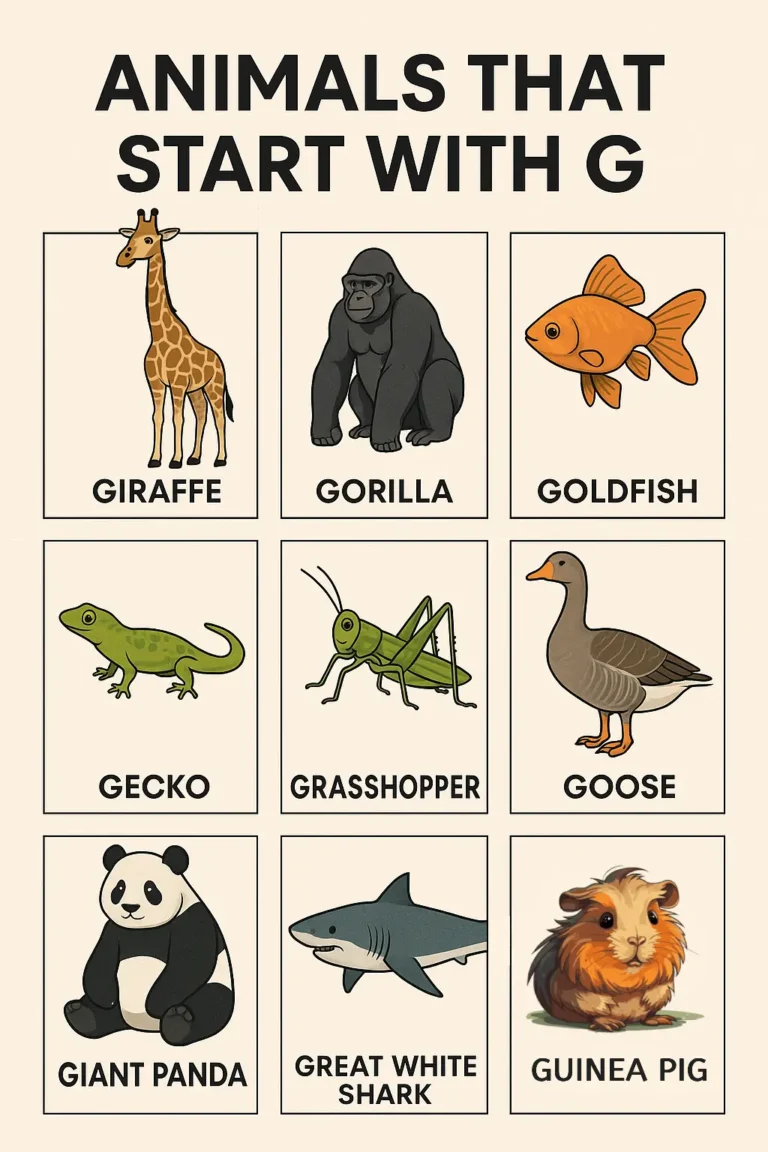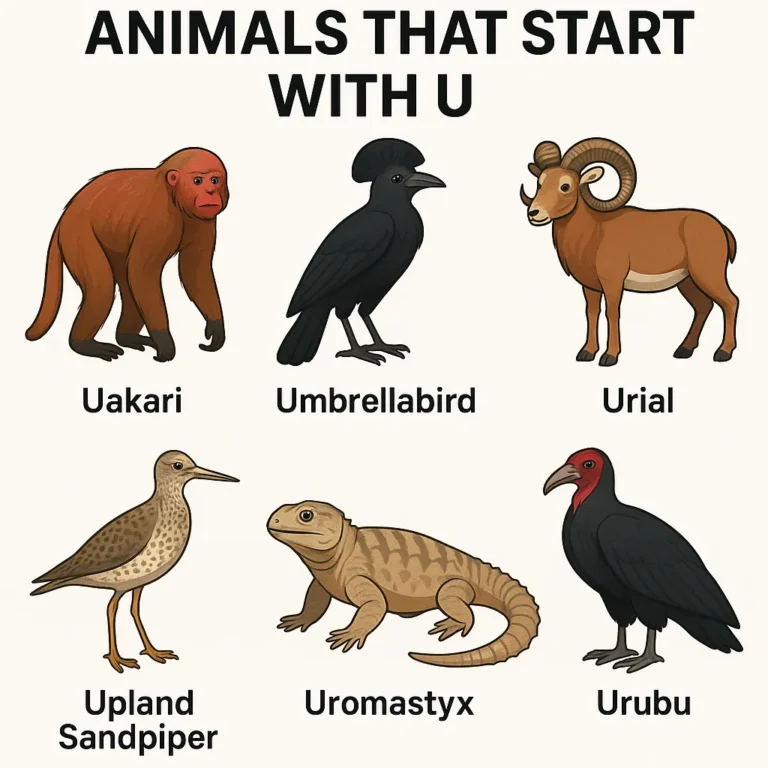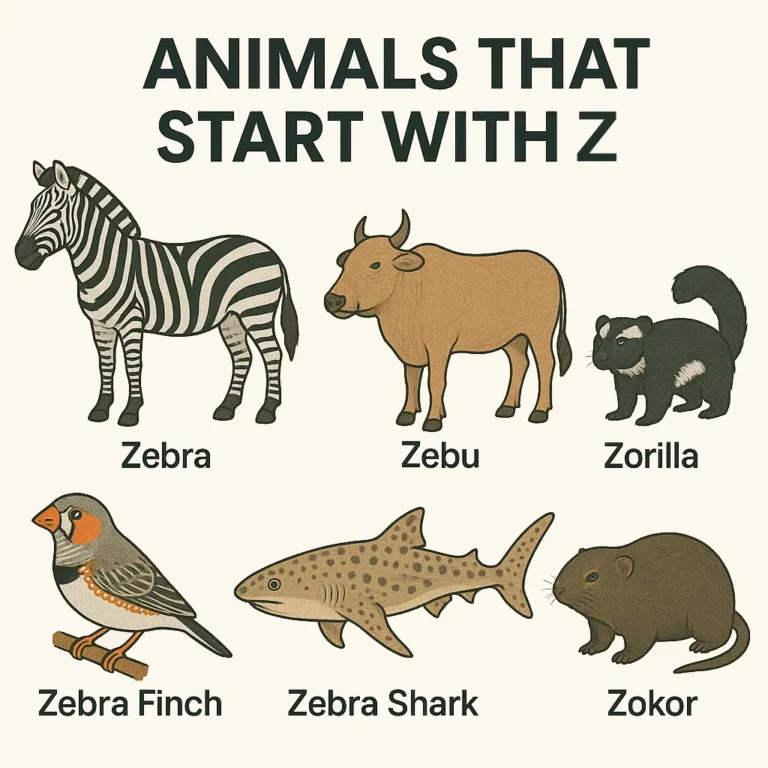Animals That Start With W | List & Examples

Many people search for animals by their first letter for school projects, word games, or general learning. This article covers a wide range of animals that start with the letter W. You’ll find examples of both domestic and wild animals, along with helpful facts about each one.
Here’s the simple list of animals that start with W :
- Walrus
- Wombat
- Wolf
- Whale
- Weasel
- Woodpecker
- Wolverine
- Warthog
- Wildebeest
- Wasp
- Water Buffalo
- Wallaroo
- Wren
- Wallaby
- Woodchuck
- Whippet
- Welsh Corgi
- Wirehaired Terrier
- Weimaraner
- Water Dragon
- White-tailed Deer
- Wild Boar
- Wrasse
- Wolffish
- Wahoo
- Weaver Bird
- Whitefish
- Warbler
- Widow Spider
- Water Moccasin
- Wombat
- Windigo
- Weevil
- Walkingstick
- Water Strider
- Whirligig Beetle
- Woolly Bear
- Wireworm
- Warble Fly
- Whale Shark
- Western Diamondback
- Wood Duck
- Wood Frog
- Whistling Duck
- White Rhinoceros
- Willow Ptarmigan
- Wire-haired Fox Terrier
- Water Vole
- Woodrat
- Wapiti
- Waxwing
- Whiteface Monkey
- Wildcat
- Willet
- Wigeon
- Wisent
- Woodcock
- Wombat Rat
- Woolly Monkey
- Worm Snake
Check out the animals that start with the letter X
Domestic Animal Names That Start With W
Here’s a list of domestic animals that start with W :
- Welsh Corgi
- Weimaraner
- Whippet
- Wirehaired Terrier
- Wire-haired Fox Terrier
- West Highland White Terrier
- Wheaten Terrier
- Wensleydale Sheep
- Welsh Mountain Sheep
- Welsh Pony
- Westphalian Horse
- Warmblood Horse
- Welsh Harlequin Duck
- White Leghorn Chicken
- Wyandotte Chicken
1. Welsh Corgi
The Welsh Corgi is a small dog breed that comes from Wales. These dogs have short legs and long bodies, which makes them look unique compared to other dog breeds. Welsh Corgis are very popular as family pets because they are friendly and smart.
There are two main types of Welsh Corgis: the Pembroke and the Cardigan. The Pembroke Welsh Corgi is more common and has a shorter tail. Both types were originally used to herd cattle and sheep on farms in Wales.
Welsh Corgis are known for being loyal and energetic. They need regular exercise and enjoy playing with their owners. These dogs are also famous because Queen Elizabeth II of England owned many Pembroke Welsh Corgis throughout her life.
2. Weimaraner
The Weimaraner is a large dog breed that was first developed in Germany. These dogs have a distinctive gray coat that can range from light silver to dark gray. Weimaraners are athletic dogs that were originally bred for hunting large game like deer and boar.
Weimaraners are known for their high energy levels and need for regular exercise. They make good family pets but require training and socialization from a young age. These dogs are very loyal to their owners and can sometimes be protective of their family.
The breed is sometimes called the “Gray Ghost” because of their gray coat and their ability to move quietly while hunting. Weimaraners are intelligent dogs that can learn commands quickly, but they need consistent training to prevent behavioral problems.
3. Whippet
The Whippet is a medium-sized dog breed that looks like a smaller version of a Greyhound. These dogs are known for their speed and were originally bred for racing and hunting small game like rabbits. Whippets can run up to 35 miles per hour, making them one of the fastest dog breeds.
Despite their racing background, Whippets are calm and gentle dogs that make excellent family pets. They are often called “40-mile-per-hour couch potatoes” because they love to run fast but also enjoy relaxing at home. Whippets are good with children and other pets when properly socialized.
These dogs have short, smooth coats that come in many different colors and patterns. Whippets are relatively easy to care for and don’t require extensive grooming. They do need regular exercise but are content with short bursts of activity followed by rest periods.
4. Wirehaired Terrier
Wirehaired Terriers are a group of dog breeds that have rough, wiry coats. The most common type is the Wire Fox Terrier, which was originally bred in England for fox hunting. These dogs have a distinctive coat texture that feels coarse to the touch and helps protect them from thorns and rough terrain.
Wire Fox Terriers are small to medium-sized dogs that are known for their brave and energetic personalities. They were bred to go into fox dens and chase out the foxes for hunters. This background makes them confident and sometimes stubborn dogs that need consistent training.
These terriers are intelligent and can learn tricks and commands quickly. They make good family pets but need regular exercise and mental stimulation to prevent boredom. Wire Fox Terriers are also known for their distinctive beard and eyebrows, which give them an alert expression.
5. West Highland White Terrier
The West Highland White Terrier, often called a “Westie,” is a small dog breed from Scotland. These dogs have bright white coats and cheerful personalities that make them popular family pets. West Highland White Terriers were originally bred to hunt rodents and small game on Scottish farms.
Westies are known for being confident and friendly dogs that get along well with children and other pets. They have a double coat that keeps them warm in cold weather, but they need regular grooming to keep their white fur looking clean and healthy. These dogs are also known for their distinctive pointed ears and dark eyes.
West Highland White Terriers are active dogs that enjoy walks and playtime, but they don’t require as much exercise as larger breeds. They are intelligent and can be trained easily, though they sometimes show the independent streak that is common in terrier breeds.
Wild Animal Names That Start With W
Here’s a list of wild animals that start with W :
- Walrus
- Wolf
- Whale
- Wolverine
- Warthog
- Wildebeest
- Wombat
- Wallaby
- Woodpecker
- Weasel
- Water Buffalo
- White-tailed Deer
- Wild Boar
- Woodchuck
- Wasp
- Whale Shark
- Western Diamondback
- Wood Duck
- Warbler
- Wildcat
6. Walrus
The walrus is a large marine mammal that lives in the Arctic Ocean. These animals are easily recognized by their long tusks, which can grow up to three feet long. Walruses use their tusks to pull themselves out of the water onto ice floes and to break through ice.
Walruses are among the largest seals in the world, with adult males weighing up to 4,000 pounds. They have thick, wrinkled skin that helps protect them from the cold Arctic waters. Walruses are social animals that often gather in large groups on beaches or ice floes.
These marine mammals eat mainly clams, mussels, and other shellfish that they find on the ocean floor. Walruses can dive up to 300 feet deep and hold their breath for up to 30 minutes while searching for food. They play an important role in Arctic ecosystems and are considered a keystone species.
7. Wolf
The wolf is a wild member of the dog family that lives in forests, mountains, and tundra across North America, Europe, and Asia. Wolves are the ancestors of domestic dogs and share many similar features, but they are larger and more muscular than most dog breeds.
Wolves live in family groups called packs, which usually consist of a mated pair and their offspring. They are skilled hunters that work together to catch large prey like deer, elk, and moose. Wolves communicate with each other through howling, body language, and scent marking.
These animals play an important role in maintaining healthy ecosystems by controlling prey populations. Wolves were once found throughout most of North America, but their numbers decreased significantly due to hunting and habitat loss. Conservation efforts have helped wolf populations recover in some areas.
8. Whale
Whales are large marine mammals that live in oceans around the world. There are two main types of whales: toothed whales (like sperm whales and orcas) and baleen whales (like blue whales and humpback whales). Baleen whales filter small fish and krill through special plates in their mouths, while toothed whales hunt larger prey.
The blue whale is the largest animal that has ever lived on Earth, reaching lengths of up to 100 feet and weighing as much as 200 tons. Despite their huge size, many whales eat very small organisms like krill and small fish. Whales are intelligent animals that can communicate with each other over long distances using sounds.
Whales breathe air through blowholes on top of their heads and must come to the surface regularly. Many whale species migrate long distances between feeding and breeding areas. Whales have been important to human cultures for thousands of years, but some species were hunted to near extinction before international protection laws were established.
9. Wolverine
The wolverine is a powerful carnivorous mammal that lives in northern forests and tundra regions of North America, Europe, and Asia. Despite their name, wolverines are not related to wolves but are actually the largest members of the weasel family. They have thick, dark fur and strong, muscular bodies built for life in harsh environments.
Wolverines are known for their incredible strength and ability to take down prey much larger than themselves. They have powerful jaws and sharp claws that help them hunt and scavenge for food. Wolverines are solitary animals that travel long distances across their territory in search of food.
These animals are well-adapted to cold climates and can travel across snow without sinking due to their large, snowshoe-like paws. Wolverines are rare animals that need large territories to survive, making them vulnerable to habitat loss and human development.
10. Warthog
The warthog is a wild pig that lives in Africa, mainly in savannas, grasslands, and woodland areas. These animals get their name from the large, wart-like growths on their faces, which are actually fat deposits that help protect them during fights. Warthogs have sparse hair and gray-brown skin that helps them blend into their surroundings.
Warthogs are omnivores that eat grasses, roots, fruits, and sometimes small animals. They use their strong snouts to dig for food in the ground and can often be seen kneeling on their front legs while feeding. Warthogs are social animals that live in family groups called sounders.
These African animals are known for their distinctive curved tusks and their ability to run up to 30 miles per hour when threatened. Warthogs are prey animals for lions, leopards, and other large predators, so they must always be alert for danger. They often sleep in underground burrows for protection.
11. Wildebeest
The wildebeest, also known as the gnu, is a large antelope that lives in eastern and southern Africa. These animals are famous for their annual migration, where millions of wildebeest travel across the Serengeti in search of fresh grass and water. This migration is one of the most spectacular wildlife events in the world.
Wildebeest have sturdy bodies, curved horns, and long faces that help them graze on tough grasses. They live in large herds that can contain thousands of animals. During the migration, wildebeest face many dangers including river crossings where crocodiles wait and predators like lions that follow the herds.
These animals play a crucial role in African ecosystems by grazing grasslands and providing food for predators. Wildebeest are well-adapted to life on the African savanna and can go without water for several days if necessary. Their migration patterns have remained largely unchanged for thousands of years.
12. Wombat
The wombat is a marsupial that lives in Australia and is known for its cube-shaped droppings. These sturdy animals have short legs, barrel-shaped bodies, and powerful claws that they use for digging extensive burrow systems. Wombats are herbivores that eat grasses, roots, and bark.
Wombats are excellent diggers and can create burrows up to 100 feet long with multiple chambers. They are mostly active at night and spend their days sleeping in their burrows. Wombats have very slow metabolisms and can survive on poor-quality food that other animals cannot digest.
These unique marsupials have backwards-facing pouches to prevent dirt from getting in while they dig. Baby wombats, called joeys, stay in their mother’s pouch for about six months. Wombats are surprisingly fast runners and can reach speeds of up to 25 miles per hour despite their stocky appearance.
13. Wallaby
The wallaby is a smaller relative of the kangaroo that lives in Australia and nearby islands. There are about 30 different species of wallabies, ranging from the tiny musky rat-kangaroo to the large antilopine wallaby. These marsupials are known for their powerful hind legs and long tails that help them hop and balance.
Wallabies live in various habitats including forests, grasslands, and rocky areas. They are herbivores that eat grasses, leaves, and fruits. Like kangaroos, wallabies are marsupials, which means they carry their babies in pouches. Baby wallabies are called joeys and stay in their mother’s pouch for several months.
Different species of wallabies have adapted to different environments. Rock wallabies live in rocky areas and have excellent climbing abilities, while pademelon wallabies prefer dense forests. Some wallaby species are endangered due to habitat loss and introduced predators like foxes and cats.
14. Woodpecker
Woodpeckers are birds that are specially adapted for climbing trees and pecking holes in wood. There are over 200 species of woodpeckers found around the world, except in Australia and Antarctica. These birds have strong, chisel-like beaks, long tongues, and specialized feet with two toes facing forward and two facing backward.
Woodpeckers peck holes in trees for several reasons: to find insects to eat, to create nesting cavities, and to communicate with other woodpeckers. They have thick skulls and special brain structures that protect them from injury while pecking. Most woodpeckers have stiff tail feathers that help support them while they climb.
These birds play an important role in forest ecosystems by controlling insect populations and creating nesting holes that other animals use. Woodpeckers eat insects, tree sap, nuts, and fruits depending on their species. Some woodpeckers, like the acorn woodpecker, store thousands of acorns in specially made holes for winter food.
15. Weasel
Weasels are small, carnivorous mammals that belong to the mustelid family, which also includes otters, badgers, and wolverines. These animals have long, slender bodies and short legs that allow them to chase prey into small spaces like burrows and crevices. Weasels are found throughout North America, Europe, and Asia.
Weasels are skilled hunters that primarily eat small rodents like mice, voles, and rats. They are known for their quick movements and ability to kill prey much larger than themselves. Weasels have high metabolisms and must eat frequently to maintain their energy levels, sometimes consuming up to 40% of their body weight daily.
Many weasel species change color with the seasons, growing white winter coats for camouflage in snow and brown summer coats for warmer months. Weasels are solitary animals that are active both day and night. They are important predators that help control rodent populations in their ecosystems.
Conclusion
This article covered many different animals that start with the letter W, from domestic pets like Welsh Corgis and Weimaraners to wild animals like whales and wolves. You learned about animals from various habitats including forests, oceans, grasslands, and homes around the world. Whether you’re working on a school project, playing word games, or just curious about wildlife, these animals that start with W show the amazing diversity of life on Earth.
If you enjoyed learning about these animals, you might want to explore animals that start with other letters of the alphabet. Each letter offers its own unique collection of fascinating creatures with different adaptations and ways of life.






